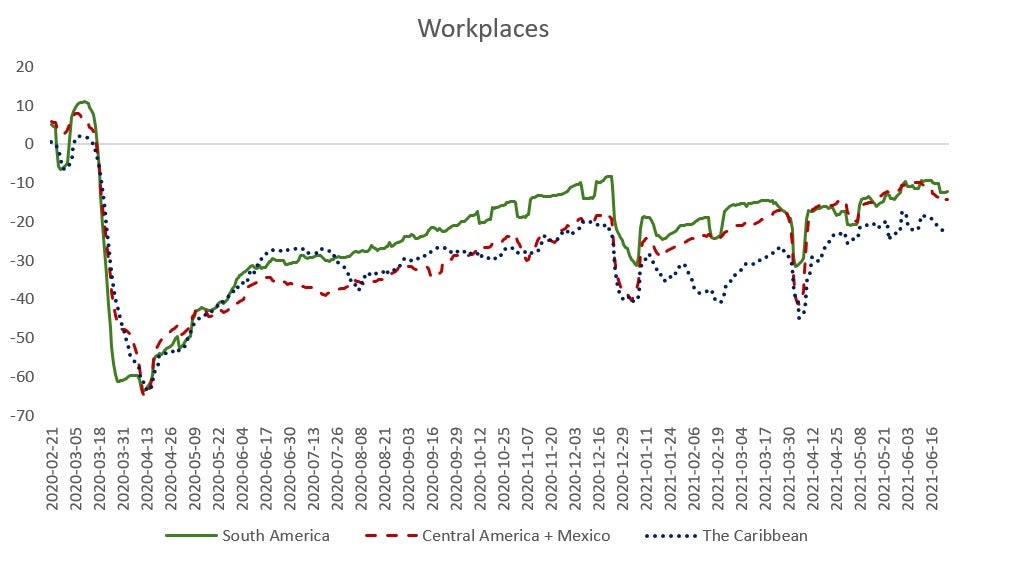
In recent years, advances in the standardization and statistical treatment of standard variables have allowed greater precision in the reporting of short- and long-term economic activity, including, among others, GDP, inflation, and the unemployment rate. But the application of the complex, technical methodologies required in arriving at those calculations has also delayed the data’s publication, frustrating policymakers who must make informed and timely decisions.
That has been especially difficult during the COVID-19 pandemic. So policymakers have turned to big data in everything from cell phones, social media and Google searches to evaluate how people are responding to quarantine measures, including changes in mobility and social distancing, among other questions.
The Emergence of Nowcasting
A related development has been the emergence of models called Nowcasting, which use high-frequency data to predict the behavior of variables in the very near future. Increasingly sophisticated, Nowcasting’s methodologies integrate big data and machine learning algorithms to maximize accuracy and facilitate the selection of variables. Provided the models incorporate economic theory and avoid outcomes based on spurious relationships, they can provide extremely valuable information on the current conditions of the economy.
Today, institutions like the Federal Reserve Bank of Atlanta and the Federal Reserve Bank of New York publish the results of their Nowcasting models regularly. Researchers at different central banks in Latin America and the Caribbean, like the Central Bank of Argentina, the Central Bank of Chile, the Central Bank of Colombia, the Central Bank of Mexico, and the Central Bank of Peru have also developed Nowcasting models based on available country-specific data.
Some countries in Latin America and the Caribbean, however, are not using Nowcasting because they lack sufficient data. This is partly a result of the region’s virtually nonexistent regulation over the use of personal data compiled on the internet and represents another reason to develop norms that both guarantee users’ privacy and allow the use of anonymized data for academic and public policy purposes. If countries in the region could pass legislation to ensure that information and communication technologies were used responsibly, there would be abundant data to serve as inputs in Nowcasting models.
Essential Data Inputs
A good example of such inputs are Google Mobility data, which show how the pandemic has influenced mobility in key areas: retail and recreation; groceries and pharmacies; parks; transport hubs (for subways, buses, and trains); workplaces; and homes. Using its Google Maps data and taking as reference the average mobility in these categories between January 3 and February 6, 2020, Google publishes the percentage changes for each one. Below we present the weekly moving average of the data for commerce and workplaces for countries in South America, Central America and Mexico, and the Caribbean.


Google data have to be used with caution when it comes to macroeconomic analysis. Given that the reference is estimated using the first month of 2020 alone, the data ignore seasonal effects, thus producing under and over-estimates of the growth rate of mobility. But if that is taken into account, it still provides key information. And the problem could be corrected easily if Google used its historical records and published the growth rate with respect to the same day of previous years.
During the pandemic, mobility information has been vital. It has helped to illuminate the efficacy of lockdowns in terms of public health. It has shown the relationship between the restoration of movement and the propagation of COVID, the places that most correlate with contagion, and how vaccination is linked to mobility’s restoration.
In economic terms, it has helped to illustrate the transit of people in the course of doing business, and the dynamic of their return to workplaces. The former provides information regarding the recovery of the demand side, and the latter, information about the recovery of the supply side.
The World Bank published a working paper with a Nowcasting model that uses Google Mobility data to forecast the industrial production for some Latin American countries. Among other advantages, the model presented in the paper showed less predictive errors than other conventional autoregressive models.
Other data used to monitor day-to-day economic activity can also serve as inputs for Nowcasting models. Banks’ records of business transactions, for example, provide solid information on economic activity, even in Latin America and the Caribbean, where the levels of financial depth are low. Central banks in the region, such as Chile and Colombia use such information regularly for their monetary policy decisions. Data on energy consumption, though often public and frequently used in the past, can be especially valuable in disaggregated form.
An Array of New Tools for Policymakers
The economic downturn wrought by the pandemic, as well as the recovery, demands assertiveness in the targeting of public resources. A necessary condition for that is data that is current. Big data, the latest information and communication technologies, and Nowcasting all provide channels by which such timely data can be processed to satisfy that need. Latin American and Caribbean countries have a long way to go in this regard. But new technologies and methodologies exist to empower policymakers to make better, more informed, and timely public policy decisions.


Leave a Reply